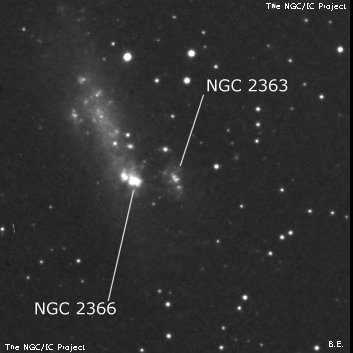NGC/IC Project Restoration Effort
(This is a very very beta version)
NGC2363


Basic Information
Location and Magnitude
Right Ascension: 7:28:29.9
Declination: +69:11:34
Constellation: CAM
Visual Magnitude: 13.0
Historic Information
Discoverer: Herschel W.
Year of discovery: 1788
Discovery aperture: 18.7
Observational
Summary description: Neb * or vF, vS, III 748 sf
Sub-type: GxyP
Corwin's Notes
=====
NGC 2363 and NGC 2366. Well, folks, it's bad news for those of us who have
always identified NGC 2363 as the giant HII region in the low surface
brightness irregular galaxy NGC 2366. WH's original description clearly
refers to the HII region as the principal object with the bit of fuzz to the
north as an incidental appendage.
This view was further solidified by Ralph Copeland, observing with Lord
Rosse's 72-inch reflector. Copeland identified the HII region as the center
of an greatly extended object, stretching 9 or 10 arcmin to the northeast.
He lists micrometric measurements of seven different objects in the
surrounding area, and all are clearly referred to the HII region. Here is a
list of his measurements, along with mine (made from the POSS1 blue print):
Copeland Corwin Note
Object P.A. Dist. P.A. Dist.
* 9.5 6.3 214.9 7.5 211
* 10 337.9 191.9 335 193
* 10 340.8 235.8 339 236
* 8 351.0 396.6 351.5 400
Dif neb 265.9 71.4 274 70.5 Copeland quadrant error?
Neb * 318.0 77.6 318 75.2 Star sup on F ext of galaxy
"Tail" 30.9 [9-10min] 31 8min+- Main body of the galaxy
So, the historical record is unmistakeable: NGC 2366 is the HII region. We
can, of course, also include the rest of the galaxy under this number, since
it was certainly seen. For the sake of the modern catalogues, this is also
certainly the best thing to do.
But what then is NGC 2363? One of Copeland's micrometric measures above --
for the "Diffused nebulosity preceding" -- is the one that Dreyer put into
the NGC with the note "III 748 s[outh] f[ollowing]." This, combined with
Copeland's measurement which Dreyer used, clearly points to the smaller object
that we now call UGC 3847 = MCG +12-07-039 (N2366 is U3851) -- it is NGC
2363, not the HII region. I have usually taken this object to be a detached
star cloud of N2366, but Steve Odewahn has shown through his detailed study of
the velocity fields of the objects that it is indeed a separate galaxy
interacting with N2366.
So, we have two galaxies here, along with two NGC numbers clearly attached to
each one. We shall just have to get used to calling the HII region
"Markarian 71" (or one of its other names) since it is not N2363 as we've
thought all these years.
There is still one other nebulous object seen by Copeland in the area. This
is the "Nebulous star or nebulous knot" which is listed in the table above.
Why didn't Dreyer include it in the NGC, too? Other objects with just that
sort of description were included. While this is an unanswerable question,
it's possible that Dreyer had access to other notes that were not published.
Or, since he and Copeland were colleagues at the time, the two of them may
well have decided that the object was a star. The object is indeed a star
superposed on a faint extension of NGC 2363. There may also be a distant
background galaxy adding to the appearance of nebulosity -- see the lovely
200-inch photographs in the Revised Shapley Ames Catalogue (page 113) and in
the Carnegie Atlas (Panel 327).
Steve's Notes
=====
NGC 2363
48" (4/15/10): NGC 2363 is either a small satellite galaxy of NGC 2366 or possibly a detached star cloud or galaxy west of the southwest end of NGC 2366. At 330x, NGC 2363 appeared fairly faint, moderately large, elongated 2:1 or 5:2 SW-NE, with a low but irregular surface brightness. Located ~2.2' SW of the center of NGC 2366 and 1.2' W of the bright knot. The bright HII knot/starburst region in NGC 2366 is often misidentified as NGC 2363.
A 2010 study suggests NGC 2363 was very close to the southern tip of NGC 2366 less than 10 Myr ago, and could have triggered the interaction which has led to the strong episodes of star formation in the southern half of NGC 2366 as well as this galaxy.



